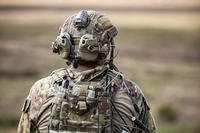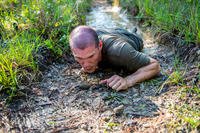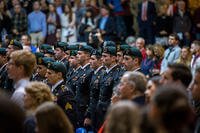Seventy years ago, out of the fog and icy mists of one of the coldest Belgian winters on record, the Wehrmacht attacked American forces along its thin defensive line in the Ardennes forest. The day will live on in the memories of the surviving American GIs who were there, as well as the German veterans, who in one final desperate surge sought to push the U.S. Army all the way back to the Atlantic ports.
Adolph Hitler, knowing that time was no longer on his side, was reaching for any straw that would buy him and his monstrous regime time. Behind massive artillery barrages in the early morning hours of Dec. 16, 1944, he launched the 6th Panzer Army against a 50-mile-long line held by undermanned U.S. infantry divisions. The Germans forces knew precisely where to strike and did so in the narrow gap between the British and American armies.
The initial artillery barrages stunned everyone due to volume alone. Allied intelligence had difficulty comprehending the massing of so many guns. After all, since D-Day, the Allies had kept the Germans on the run and despite the colossal failure of Operation Market Garden in Holland the previous September, German forces had continued to retreat back toward Germany. When the barrages lifted, German panzers surged forward against lightly armed infantrymen.
The weather worked against the Allies as well. Overcast, snow, fog and icy mists prevented the Army Air Force and the Royal Air Force from providing close air support to troops in contact with the enemy. Allied air superiority was completely negated by Old Man Winter. On the ground, American troops fought delaying actions against better-equipped German armored units and Panzer grenadiers, many experienced in winter warfare from their fighting on the Eastern Front.
With American armor in short supply and the Air Corps and RAF grounded in England, battles on the ground grew desperate. Communications with various levels of headquarters failed and many units were overrun by German forces. American GIs fell before German guns and some broke and ran. The 106th Infantry Division, completely surrounded and facing annihilation, surrendered. It was the largest mass surrender of U.S. troops since the destruction of the American and Filipino garrisons at Bataan and Corregidor during the early days of the war in Pacific.
German SS troops fighting alongside their Wehrmacht counterparts continued to build on their reputations for merciless savagery. SS troops of Kampfgruppe Peiper assigned to the 1st SS Panzer Division, under the command of Obersturmbannfuehrer (SS Lt. Col.) Jochen Peiper, summarily executed more than 100 members of B Battery, 285th Field Artillery Observation Battalion at the Baugnez crossroads near the Belgian town of Malmedy. When word of the massacre reached the headquarters of General Eisenhower, a fragmentary order was issued, indicating that German SS troopers and fallschirmjagers (paratroopers) were not to be taken prisoner and instead, were to be shot on sight. Such was the savagery of the combat.
The American 101st Airborne Division, in rest and refit at Mourmelon, France, rushed to the front. Assigned to defend the sector around Bastogne, it filled the breach, refused to yield and entered history. When the battle ended, the division had a new nickname, the Screaming Eagles were now referred to as the "Battling Bastards of Bastogne."
The "werevolves," German soldiers who spoke flawless Americanized English and dressed like American MPs, added to the confusion by misdirecting supply and replacement convoys and assassinating American personnel. The average American GIs developed new and interesting ways to trap troops they suspected of being Germans by asking questions about movie stars, baseball players and the results of the 1944 World Series. For GIs with little or no interest in the sports results of the day, the questions also created fears that they might be summarily shot by their own side.
At St. Vith, the U.S. 7th Armored Division held out longer than expected and the British press screamed for Ike's removal as Supreme Allied Commander.
While the German advance succeeded in its early phases, senior German military planners had failed to consider that after initial breakthroughs, that American resolve would stiffen. German panzer formations short on diesel fuel did not have enough to fight a lengthy war of maneuver, while American fuel and ammunition continued to arrive from the ports in Belgium and Holland.
The German operations plan assumed the re-occupation of Bastogne on the second day of the offensive. After the arrival of the 101st Airborne Division, that goal was never attained. As German momentum slowed, the Panzer formations were forced to go around or avoid pockets of American resistance. Stunned by the tenacity of U.S. troops, the Germans soon faced the reality of the situation. American generals drew up new battle plans, stiffened their lines and fought on.
Lt. General George S. Patton's Third Army was turned North to deal with the German threat and, in one of the most phenomenal forced marches in military history, moved against the German flank.
A bitterly cold winter, combined with a new savagery unseen before the era of mechanized and armored warfare contributed to the loss of 100,000 German troops that Hitler would be unable to replace. The United States Army would lose 19,000 killed in action, 23,554 captured and thousands more wounded, many who would never see active service again.
As German forces were repulsed or destroyed, it became readily apparent to Field Marshall Gerd Von Runstedt that the end was near and inevitable. The once vaunted Wehrmacht's days were numbered. Once proud regiments were either destroyed or forced to withdraw back toward the Vaterland. For many German soldiers, this last near cataclysmic battle destroyed any hope for a negotiated peace. As German formations headed eastward, they knew that the inexorable advance of American, British, Canadian, and other allied troops would not be stopped.
The Battle of the Bulge lasted for 40 days and ended in January 1945. Less than six months later, Hitler would be dead and the Thousand Year Reich toppled. Most of the major German cities were in ruins and the once super-efficient German economy in tatters. The victorious Western armies would stare across the divide in Berlin warily suspicious of their Russian allies, but uttering a collective sigh of relief. The Nazi juggernaut had been halted and, finally, destroyed.
The Battle of the Bulge showed the true mettle of "the Greatest Generation." To this day, it still offers lessons for those of us willing to learn from the past.
As someone who has studied modern military history, looking for answers applicable to current situations, the Battle of the Bulge has taught me that heroism and fortitude are values worth nurturing. The ability to endure and prevail, as those young GIs did 60 years ago this month, is a model that Americans in the early years of this new millennium should not be too quick to abandon.
Reprinted with permission of Paul Connors.
















